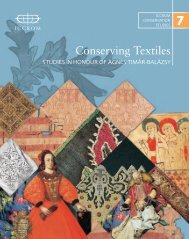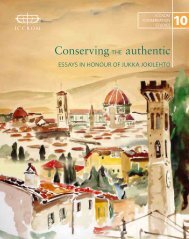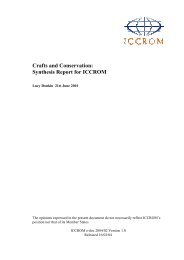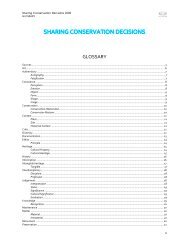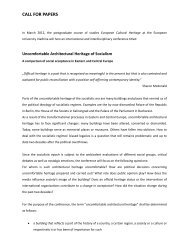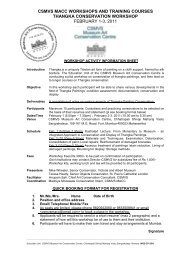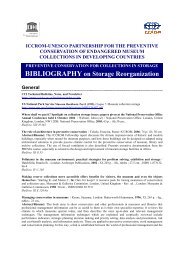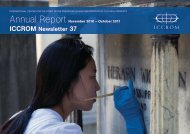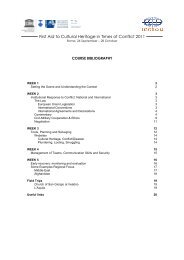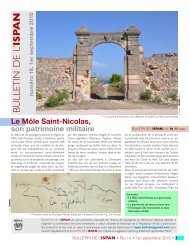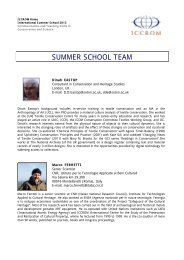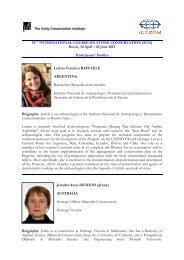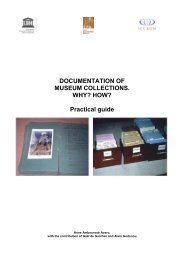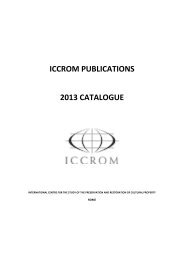part 1 - Iccrom
part 1 - Iccrom
part 1 - Iccrom
You also want an ePaper? Increase the reach of your titles
YUMPU automatically turns print PDFs into web optimized ePapers that Google loves.
MEASURING HERITAGE CONSERVATION PERFORMANCE<br />
6th International Seminar on Urban Conservation<br />
Preventive conservation aims to identify risks and<br />
mitigate the causes of deterioration of cultural property,<br />
avoiding high-impact interventions. To reach<br />
these goals, it must be based on the development of<br />
sound assessments, technologies involved, the environment<br />
around them, and the causes of the deterioration<br />
processes by addressing in a holistic way<br />
sites, buildings and collections. The methodology<br />
for making integrated conservation assessments<br />
of buildings and collections was developed by the<br />
Getty Conservation Institute (GCI), and improved<br />
for the project ‘Collection in hot and humid climates’.<br />
In the late 1990s it was consolidated in the<br />
manual The Conservation Assessment: a Proposed<br />
Model for Evaluating Museum Environmental<br />
Management needs (Dardes, 1998). Organized by<br />
Kathleen Dardes, GCI senior project specialist, this<br />
publication proposes the integrated analysis of<br />
macro-climate, building, collections and organizational<br />
aspects that impact on their preservation.<br />
In Brazil, the first experience of performing this<br />
type of diagnosis occurred in the Sacred Art Museum<br />
of Federal University of Bahia in 1998 from a <strong>part</strong>nership<br />
between the Museum, the GCI, the Vitae<br />
Foundation and the Centre for Conservation and<br />
Furniture Restoration of Cultural Property, Federal<br />
University of Minas Gerais (UFMG-CECOR). One<br />
of the aims of this study was to test the adequacy of<br />
the methodology of the GCI in Brazilian institutions.<br />
The Sacred Art Museum comprises an important<br />
collection formed by 17 th century buildings, which<br />
housed the former Convent of St. Teresa of Avila,<br />
and the collection of pieces of religious art from the<br />
17 th to the 19 th century that originate from different<br />
religious brotherhoods. The project sought to identify<br />
the causes and agents of deterioration processes<br />
of the building and collections, and set guidelines<br />
for short, medium and long term improvement of<br />
storage conditions on the whole.<br />
Since the work of the Museum of Sacred Art, some<br />
positive examples of applying this method of conservation<br />
assessment made by Brazilian institutions<br />
responsible for preservation of cultural artefacts<br />
have shown the effectiveness of this tool.<br />
Fundação Casa de Rui Barbosa (FCRB), a public institution<br />
under the Ministry of Culture based in Rio de<br />
Janeiro, is responsible for preserving the memory<br />
of the life and work of Rui Barbosa through custody,<br />
preservation and dissemination of his patron<br />
legacy: his home, furniture, library and archive<br />
records. Since 1997 FCRB has been conducting a<br />
long-term study to develop preventive strategies<br />
for the conservation of movable and immovable<br />
property under its stewardship, adopting the methodology<br />
proposed by GCI as a base for the different<br />
stages of assessment, understood by the staff as a<br />
tool knowledge in the present and the future.<br />
Fundação Oswaldo Cruz (Fiocruz), a public research<br />
institution linked to the Ministry of Health, also<br />
based in Rio de Janeiro, is responsible for the<br />
preservation of an important collection related to<br />
cultural heritage of health care, including historic<br />
buildings, archival collections, photographs, bibliographic<br />
material, and museum of biology. Given<br />
the enormous diversity of cultural property under<br />
its responsibility, the Casa de Oswaldo Cruz (COC),<br />
one of the de<strong>part</strong>ments responsible for the preservation<br />
of cultural heritage of this institution, in 2008<br />
created a team of multiple professionals composed<br />
of experts from several de<strong>part</strong>ments whose goal is<br />
to design, organize and develop action plans for<br />
implementation of preventive conservation. As a<br />
result this group is developing the research project<br />
‘Preventive conservation of collections maintained<br />
by Casa de Oswaldo Cruz’, selected by a research editor<br />
promoted by COC in 2009, and with estimated<br />
completion in first half of 2011. The development<br />
project has the support of FCRB, through a <strong>part</strong>nership<br />
established between the institutions.<br />
This article aims to present the development of this<br />
research, demonstrating the importance of using<br />
consistent tools to assess and record the various factors<br />
that may impact on the conservation of cultural<br />
property. The conservation assessment tools are<br />
important not only for the definition of conservation<br />
strategies, but also for monitoring the effectiveness<br />
of those actions.<br />
1. Characterization of the study object<br />
Fiocruz was created in 1900 with the goal of fighting<br />
the great problems present in the Brazilian public<br />
health care system. Currently, its purpose is to<br />
promote health and social development, to generate<br />
and spread scientific and technological knowledge<br />
and to be an agent for citizenship. Its headquarters<br />
are in the city of Rio de Janeiro, in the neighbour-<br />
hood of Manguinhos, where the first buildings constructed<br />
to house the institution’s activities remain<br />
preserved and where collections of great importance<br />
to Brazil’s national heritage are gathered.<br />
The Casa de Oswaldo Cruz (COC) is the technicalscientific<br />
unit of Fiocruz responsible for the preservation<br />
of the institution’s memory. The heritage<br />
Teixeira Coelho, A. M. & .C. S. Rodrigues de Carvalho. 2012. The conservation assessment as a tool for cultural heritage identification,<br />
monitoring, and evaluation. In Zancheti, S. M. & K. Similä, eds. Measuring heritage conservation performance, pp. 82-89. Rome, ICCROM.<br />
83



